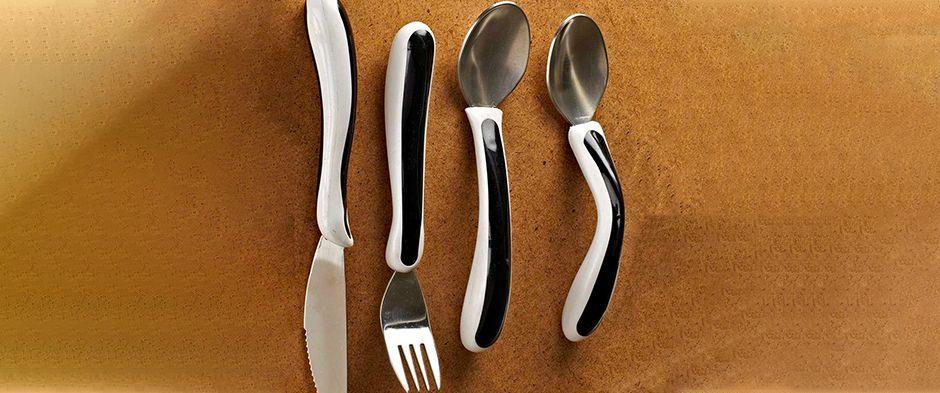
Clever Adapted Cutlery Makes A Difference At Mealtimes
Sally Madeley-Carr, OT18 Feb 2020
There are a number of health conditions which may make it difficult to eat with standard cutlery. Hand and arm tremors, reduced strength or limited motor control can have a dramatic impact on someone's ability to feed themselves. In these circumstances, mealtimes may become a trial, but equipment is available to mitigate the problem.
Essential Aids recommends that before choosing special cutlery, an occupational therapist assesses the particular needs of the person concerned. They will have a clear picture of the specific situation and will advise on the best options for the individual.
Examples of conditions which may lead to the need for special cutlery
Multiple Sclerosis | Motor Neurone Disease/ALS | Peripheral Neuropathy | Parkinson's Disease | Brain Injuries | Cerebral palsy | Arthritis / Dementia
Adapted cutlery
The processes behind the seemingly simple skill of feeding oneself are in fact complex. The physical movements involved rely on a string of bodily operations like balance, strength and coordination to all work in sync. Still more complicated are the mental processes taking place which result in the eventual movement.
With such a fine balance of interacting components, it's perhaps not surprising that certain health conditions lead to difficulties controlling conventional spoons, knives and forks along with other kitchen aids and utensils. This is especially true of people with cognitive changes or deterioration, for example, Alzheimer's Disease. Or physical limitations caused by disease, such as arthritis.
Cutlery with 'built-up' handles
Most standard cutlery tends to be quite narrow in design and it is not always easy to hold with adequate control and pressure. Simply using items with larger handles can for some people make a substantial difference. By expanding the diameter of the handle, less pressure is required.
Cutlery is available with oversized handles or you can choose to adapt standard items. This can be done by wrapping the handles with a form of tape. Alternatively you can encase the handles in a foam, increasing their size and also making them less slippery to the touch. Not having to wrap the fingers quite as tightly makes a big difference to some people, especially those experiencing pain in their hands.
Cutlery with moulded or contoured grips
Along the same lines, using cutlery with moulded handles may have similar benefits. As the name suggests, these have contoured handles which provide a more natural fit with the hand, improving comfort and requiring less of a tight squeeze. Some also have splayed 'necks' preventing the thumb slipping forward.
Weighted Cutlery
Using heavier cutlery is considered by some to make it easier to control. It's most often used for those with a tremor, with the additional weight going some way to suppressing the extra movement. Using a weighted wrist cuff in some cases helps for the same reason.
Cutlery with an 'angled' head
This type of cutlery has the forked or scooping component set at an offset angle to the handle. For some, this adaptation helps keep the head in a horizontal position despite shaky movement. The offset angle may make it easier to direct food into the mouth as it reduces the amount of wrist dexterity required.
In some cases the head of this type of cutlery is set at a particular angle, which allows the neck to be bent freely to achieve the desired curve.
Before making a choice, consider if the user is right or left handed - this type of cutlery is available for both.
Hand straps
Some items of cutlery are available with straps to prevent them falling if the user loses their grip. If you're suffering from severe tremors or loss of strength in the fingers, you may find you are prone to dropping items of cutlery while eating. Cutlery straps typically fit around the back of the hand and usually fix with Velcro.
Lightweight cutlery
For those with significantly reduced strength, cutlery that is very light in weight might help. Usually made from plastics like polypropylene, it is a popular choice for some children with disabilities or very frail adults.
Solutions for people using one hand
In the aftermath of a stroke or because of certain disabilities, some people are left with the use of only one hand. While using a spoon is a partial solution for food which might previously required a knife and fork, there are single items of cutlery which allow you cut up food and fork it too.
One widely used product is the 'knork'. It combines a standard fork at one end, along with a cutting blade on one side of the edge of the prongs.
This design allows the user to cut the food and raise it to the mouth. It has a simple efficiency and is effective for eating foods which don't lend themselves to spoons.
Using a knork style implements does involve raising a bladed item to the mouth, so it is never recommended for people with tremors or prone to jerky movements.
Without the luxury of being able to apply pressure using a knife and fork together to pick up food, another possible solution is the use of high-sided bowls. These make it easier to press against in order to scoop food up.
Rocker knives
These are specially designed knives with a curved blade. The user 'rocks' the blade back and forth on the food in order to cut it, reducing the downward pressure required by most knives. This rocker action also means a fork is not needed to stablise the food as it's being cut.
Some rocker knives have vertical handles, with the grip protruding upwards from the midway point of the blade. Others are designed more conventionally, with a horizontal handle.
Plastic coated cutlery
People with a strong or uncontrolled bite reflex may be in danger of injuring their mouths when eating. For those in this situation, fully plastic cutlery or metal cutlery with a plastic coating is less like to cause damage even if bitten hard.
It's worth bearing in mind that other special kitchen aids like non-slip mats often work well in combination with adapted cutlery. Preventing bowls and plates from slipping around on table surfaces creates one less variable.
Health conditions which may lead to the need for adapted cutlery
A loss of dexterity of strength in the hands and fingers is a symptom of a number of conditions, many associated with old age. In some cases this can be temporary, with improvement occurring in a short space of time. In others it is more long-lasting, leading to difficulties in a number of routine tasks requiring stability, strength and fine motor control of the hands.
If you experience weakness in one or both of your hands, it's vitally important that you visit your doctor. If it happens suddenly, it may be a result of a serious medical emergency like a stroke, so you should call an ambulance immediately.
Carpal tunnel syndrome
A common condition which may lead to hand weakness is carpal tunnel syndrome. This is an 'overuse' injury and affects the wrists, arms and hands. It can be provoked by repetitive physical patterns of movement like typing at a computer or machine operation.
It develops when swelling within the wrist applies pressure to the tissue, compressing a collection of nerves located in the 'tunnel' between bones in the area where the forearm meets the hand. In its early stages or in its mildest form, this may lead to tingling in the fingers but if it worsens, this can turn into a numbing sensation, weakness and a lack of coordination in the hands.
Carpal tunnel syndrome is often relieved simply by changing the pattern of movement which brought it on, decreasing the 'repetitive strain'. Wrist braces can also be effective in reducing pressure on the 'tunnel' area.
Neuropathy
Neuropathy can arise because of a complication of diabetes or result from other issues like dietary deficiencies, metabolic problems or even the side effects of certain medication. Neuropathy is an injury to nerves, usually those affecting the feet or hands. It may lead to a feeling of heaviness, numbness, difficulties with coordination and sensations of tingling or pain.
Arthritis
One of the most common causes of weakness in the hands is arthritis, a painful condition affecting the joints. 'Rheumatoid' arthritis and 'osteoarthritis' account for the vast majority of cases in the UK, but there are over 100 different kinds.
When joints between bones are healthy, they move together smoothly because of some tissue called 'articular cartilage' which sits between then. This is slippery, effectively lubricating areas where bones meet with the help of an oily-feeling fluid called synovium.
Osteoarthritis, the most widespread form of arthritis and primarily affecting elderly people, arises when cartilage breaks down, through what is known as 'wear and tear' damage.
Rheumatoid arthritis on the other hand is a chronic disease in which the synovium swells, leading to stiff joints and pain. It usually starts in the small joints of the body in the feet and hands.
In more severe cases, arthritis can result in a contortion of the hands, meaning it's hard to hold cutlery at conventional angles.
There are a number of other relatively common diseases and chronic illnesses which often make using cutlery difficult, including Multiple sclerosis, Motor Neurone Disease/ALS and Parkinson's Disease, especially if they are degenerative.
People with brain injuries or learning difficulties may experience similar issues.
We strongly strongly recommend consultation with an occupational therapist before choosing kitchen aids or special cutlery.

Sally Madeley-Carr, OT
Sally qualified as an Occupational Therapist in 1996 and is a well-respected professional in the field of rehabilitation equipment and living aids. She has worked in private practice and within the NHS, developing a broad experience with adults and children. Click here for Sally's registration with the Health and Care Professions Council. The HCPC regulates health, psychological and social work professionals in the UK.